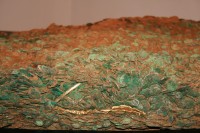 The world’s largest Iron Age coin hoard, discovered on Jersey nine years ago, has been acquired by the Government of Jersey for £4.25 million ($5.7 million). The Council of Ministers dipped into the civil asset recovery fund (moneys confiscated from criminal activities) to pay Her Majesty’s Receiver General, administrator of the Crown estate in Jersey, for the right to keep their own patrimony.
The world’s largest Iron Age coin hoard, discovered on Jersey nine years ago, has been acquired by the Government of Jersey for £4.25 million ($5.7 million). The Council of Ministers dipped into the civil asset recovery fund (moneys confiscated from criminal activities) to pay Her Majesty’s Receiver General, administrator of the Crown estate in Jersey, for the right to keep their own patrimony.
 The Le Catillon II hoard was discovered by a pair of metal detectorists in February 2012. They had been searching that field for 30 years, looking for a coin treasure based on a tale they’d heard from the previous landowner’s daughter that she and her father had found coins in a jar buried in the field when she was a little girl. After three decades of fruitless searching, Reg Mead and Richard Miles found 60 coins of the Coriosolite tribe in what is now Brittany in one location. They dug down and encountered the top of what would prove to be a massive group of Celtic coins.
The Le Catillon II hoard was discovered by a pair of metal detectorists in February 2012. They had been searching that field for 30 years, looking for a coin treasure based on a tale they’d heard from the previous landowner’s daughter that she and her father had found coins in a jar buried in the field when she was a little girl. After three decades of fruitless searching, Reg Mead and Richard Miles found 60 coins of the Coriosolite tribe in what is now Brittany in one location. They dug down and encountered the top of what would prove to be a massive group of Celtic coins.
The find site was then thoroughly excavated by archaeologists who wrapped the mass of coins, hardened by corrosion into a half-ton block, and raised it in one giant chunk for excavation at the Jersey Museum in view of  the public. Initial estimates of how many coins were crammed in there ranged from 30,000 to 50,000. As excavation continued, the estimate increased to 70,000; this turned out to be the accurate figure. Conservators then encountered a surprise: a section about the size of a shoebox containing six gold torcs. They also found other pieces of jewelry, glass beads, a leather purse and a woven bag containing silver and gold jewelry. It took five years to fully excavate the block. The last coin was removed in 2017.
the public. Initial estimates of how many coins were crammed in there ranged from 30,000 to 50,000. As excavation continued, the estimate increased to 70,000; this turned out to be the accurate figure. Conservators then encountered a surprise: a section about the size of a shoebox containing six gold torcs. They also found other pieces of jewelry, glass beads, a leather purse and a woven bag containing silver and gold jewelry. It took five years to fully excavate the block. The last coin was removed in 2017.
Treasure finds on Jersey are legally complicated because of its status as a self-governing Crown Dependency. The finders wanted the Le Catillon II hoard declared treasure under the UK’s legislation or, if the French law was applied, that it belonged to the finders and landowner. They tried to make a case of it, to loosen up the Crown Dependency chains a little bit, but nothing came of it, and a decade later it came down to a buyout. The hoard’s value was initially estimated at £10 million, so at least they got charged the friends price.
The historic collection of coins will now remain in Jersey Heritage’s care.
Part of the financial settlement included a £250,000 payment to Jersey Heritage for their work towards dismantling the coins, and an additional £250,000 which will be used to establish a trust. […]
The Crown will now undertake the work to establish an independent trust to promote scientific and educational research into the historic discovery.
Chief Minister John Le Fondre said the purchase was made “in the interest of the island”.
He said: “This is an outcome which will ensure that this unique part of Jersey’s history remains in the island for this and future generations.”
One can easily imagine Jersey being the base of a desperate band of pirates at that time! What is known of its then inhabitants?
Either war was financed, or means that had been afforded to do so, were hidden on some on some of those Channel Islands.
So to speak, “business at usual”. OK, with 250K GBP you wont get far, these days :skull:
However, the Venelli or Unelli (Gaulish: Uenelli, Οủένελλοι) were a Gallic tribe dwelling on the Cotentin peninsula, in the northwest of modern Normandy, during the Iron Age and the Roman period.
In 57 BC, they capitulated to Caesar’s legate Publius Licinius Crassus, but rebelled the following year and sent troops to help the Gallic coalition against the Roman aggressors during the Battle of Alesia (52 BC).
———-
If you ask Julius Caesar, Commentarii de Bello Gallico, 2:34, 3:11:4, 7:75:5.
———-
“At the same time he was informed by Publius Crassus, whom he had sent with one legion against the Veneti, the Venelli, the Osismi, the Coriosolitae, the Esuvii, the Aulerci, and the Redones, which are maritime states, and touch upon the Atlantic ocean, that all these nations were brought under the dominion and power of the Roman people.”
“…He sends Quintus Titurius Sabinus his legate, with three legions, among the Venelli, the Coriosolitae, and the Lexovii, to take care that their forces should be kept separate from the rest. He appoints Decimus Brutus, a young man, over the fleet and those Gallic vessels which he had ordered to be furnished by the Pictones and the Santoni, …”
“While those things are carried on at Alesia, the Gauls, having convened a council of their chief nobility, determine that all who could bear arms should not be called out, which was the opinion of Vercingetorix, but that a fixed number should be levied from each state;[…] thirty thousand from the Rauraci, and Boii; six thousand from all the states together, which border on the Atlantic, and which in their dialect are called Armoricae (in which number are comprehended the Curisolites, Rhedones, Ambibari, Caltes, Osismii, Lemovices, Veneti, and Unelli).”
“While those things are carried on at Alesia, the Gauls, having convened a council of their chief nobility, determine that all who could bear arms should not be called out, which was the opinion of Vercingetorix, but that a fixed number should be levied from each state;[…] thirty thousand from the Rauraci, and Boii; six thousand from all the states together, which border on the Atlantic, and which in their dialect are called Armoricae (in which number are comprehended the Curisolites, Rhedones, Ambibari, Caltes, Osismii, Lemovices, Veneti, and Unelli).”
http://www.thehistoryblog.com/archives/63017